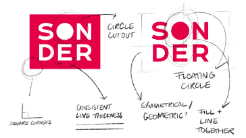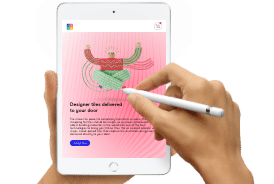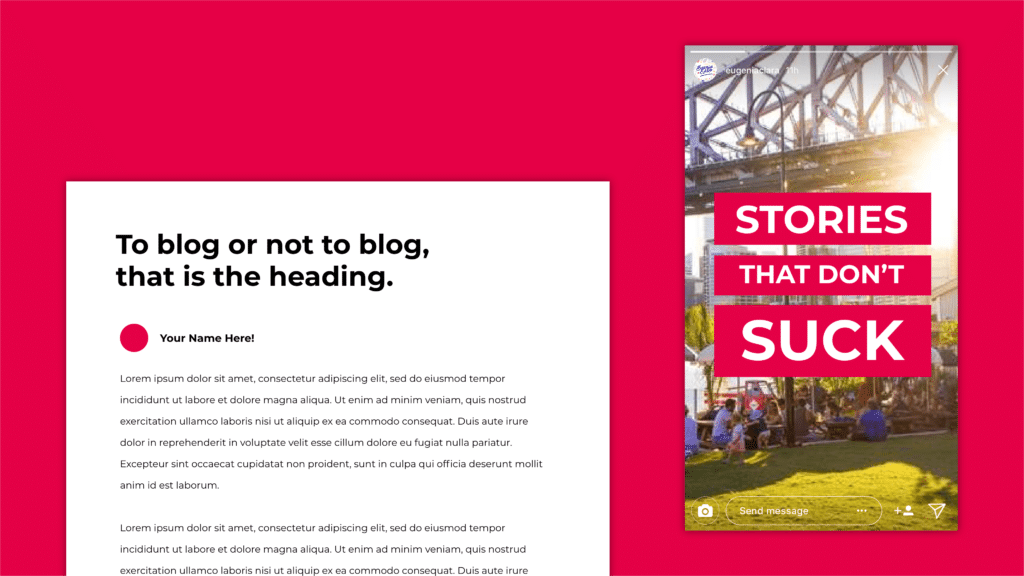We all know your marketing materials need to look good and grab attention to be successful, but the words in these materials play an even bigger role in getting you sales and business. As a business owner, especially as a small business owner or entrepreneur, the need to save on costs usually leads to you writing your own marketing materials. No one knows your business better than you, but usually, the way business owners write about their own business really misses the mark. No offence.
There are a bunch of traps you can fall into. One is talking about yourself too much — your clients really don’t care about how your grandfather inspired your start in the industry. Another is using a bunch of industry jargon — your clients are coming to you for help, not to be more confused. Or, making the mistake that, because you speak English, you can throw down words just as well as a copywriter.
We can all write, every single day we each bang out a bunch of words, whether it’s through text, social media, writing an email, a strategy, a schedule. They’re all written words. But, copywriting is about finding what the potential customer wants, what they need, what’s led to the want or need, and why this particular product or service is perfect. Then it’s about working out how to communicate that to the person, and then sitting down and writing the words.
It’s not describing a product, or saying “We offer copywriting services, our services are good, but don’t take our word for it, call the office today”. It’s saying, “Do you feel like your marketing materials fall short? Are you getting a lot of clicks but no sales? We know where your dream customer is and we know how to talk their talk. You need our words — fill in the form for a free consultation.” See the difference? It addresses their needs, it explains how we help, and then it makes it literally so easy to take the first step.
There’s plenty more where that came from. From email marketing to website copywriting and even your social media captions… Here are our top copywriting tips for business owners.
Email Marketing – Copywriting Tips
Writing subject lines
There are four simple elements to creating a quality subject line:
- Use their name
- Use emojis
- Use action words or tangible benefits
- Keep it short and simple
Every marketing email in your inbox will talk about a sale, an offer, a deal. People are overloaded with marketing emails, so give them something that makes them want to open yours. It should be specific, so don’t say, “sale on now”. Say “50% off storewide sale”. Keep it short and sweet — firstly, so it can be viewed on mobile, but also because you don’t want it to be too wordy.
It can be effective to create urgency in your subject lines too, so lines like: “12 hours only”, “you won’t want to miss this”, that kind of thing. But keep it appropriate… Your dentist emailing you about a 12 hour flash sale is a pretty uncomfortable idea. Service-based businesses particularly can benefit from after-sales follow ups. Our dentist pals probably won’t get in touch with us for a sale, but they could tell us it’s been six months since our last checkup.
Writing the preview section
The preview text in an email will come underneath the subject line on mobile or to the right of it on desktop. It’s the preview of the email. When we do marketing emails though, we get to choose the preview and this means we can create urgency, mystery, whatever you need to create to increase the chances of the email being opened.
Preview text helps people know whether they’d like to open the email. So, it should follow on from your subject line, rather than creating a new offer.
Remember, email marketing relies on personalisation and just generally sounding like a human. We’re used to seeing overtly promotional slogans and signs in traditional marketing… in an email? Not so much.
The actual email
Like we said, personalise!! Speak like a human! It’d be extremely weird to receive an email that begins with anything other than Hi [Name] or Hey [Name]. Keep it conversational. Don’t use big words, industry jargon, or language that’s too professional. If you’re sending a follow up email as part of a marketing sequence, don’t tell them you’re following up on your last email… That’s strictly reserved for marketing agencies chasing up content (you know who you are).
Seriously though, your emails should sound like you’re talking to a friend. So in your follow up you should be saying something like, “Hey [Name], did you HEAR about our pop up sale?!”.
Using their name isn’t the only way you can personalise copy. Use pronouns. Don’t say, “Sonder’s offering serious discounts this week.” Say, “I’m so excited because this week we’re offering you a serious discount.” Rationally, we know you’re not speaking to this customer directly but on a subconscious level, it feels as though you crafted this email for the one customer.
People don’t love reading, so make sure the body copy is short and sweet too. Put your key points in bold or italicise them.
The call to action
Your email marketing call to action is similar to all your other calls to action. It should be short and concise, clear, and easy. The key thing to remember in all avenues of marketing is that people are unfathomably lazy. Your long form will not be filled out. Your two sentence long call to action will not be read. Your “simple” explanation of how to get in touch will not be followed. You should also only use one call to action. Don’t confuse them.
It needs to be literally the easiest it can be. Make it as few steps for them as you possibly can. Your email should have a big bold button in the middle of it that makes it exceedingly clear what to click. The button should say exactly where it should go in as few words as possible. If it’s to book a meeting it should say, “Book Meeting”, if it’s a sale, it should say, “Go to Sale”.
Alongside the button should be a benefit-implied call to action that’s short and sweet. So, for the meeting CTA, “Maximise your sales today”, for the sale CTA, “Save up to 50% off today”.
Social Media tips for businesses
Instagram Tips
Sure, Instagram is a visual platform. But if you’re there to sell your products or services — it’s all about that caption. We know that there are different ideals and different expectations across the different social channels. If you want to read and think, you’re more likely to head to Twitter or LinkedIn, if you want to watch videos or binge articles, you might head to Facebook. Instagram’s a funny one.
It isn’t really a place to sell. It’s more so a place to warm ‘em up. This means you should be sharing nuggets of info, sharing a bit about your business, and a bit about your products or services. But there shouldn’t really be a call to action. There’s no hard sells on Instagram. Use your soft sell: “Like this tip? Follow us on LinkedIn, that’s where we post the serious stuff .”
As for writing your Instagram caption? Keep it easy to digest. You should vary your caption lengths — not every caption has to be a big informative thing. Especially if the graphic, image, or video you’re posting kind of sums it up. Maybe you’ve posted a video showing off some work you’ve done, it’s okay to share it alongside, “We loved getting to create this for @client.”
If you’re going for the long caption, be sure to break it up. Use on-brand emojis as bullet points and get to the point quickly. Remember that users have to click “see more” to see all of your long caption. So that first line? Essential. Hit them with a super bold statement, ask a question, just make sure it’s engaging and makes the user want to read on.
Facebook Tips
If you’re writing a caption to accompany a content piece you’re sharing, you’re going to be trying to encourage a click. You could pick the most interesting line from your piece and quote it in the caption to try and induce that, “I need to read this now” feeling. Or, you can write an intro to the piece that addresses why someone may need to read it.
For this blog post, we could write something like:
Do you dread sitting down to write marketing materials for your business? We have a bunch of actionable tips for you to nail your social media, website, and email marketing copy.
It addresses the struggle business owners have with their own copywriting while letting them know exactly why they should read the blog.
LinkedIn Tips
Get the headline right
To get LinkedIn users to the part where they actually read your article, you need a solid headline to draw them in. If you’re in B2B you know how lucrative a good LinkedIn article can be for your business.
LinkedIn has highlighted some top tips for their headlines. There are a bunch of tips in there around trigger words, along with statistics around certain words or topics and their open rates. But the biggest takeaway from the post is that your headline should communicate the benefit of reading the post. Whether it’s by asking them a question, to which you know the answer is yes: Do You Want More Customers? Or, you just specify the benefit up front: “5 Ways To Get More Business Now”. Communicating the benefit of the post is the first step to earning a click.
Keep it simple
When you’re writing for a LinkedIn audience, you may think that because it’s a B2B platform, your readers will be able to understand a complex subject matter and therefore complex content. You’re right, they probably can. It doesn’t mean they want to… Don’t make people work for your content. In journalism, the rule of thumb in articles is that if an 11 year-old can’t read it — it’s too complex. Dumb it down for the greater good, honestly.
Website Copywriting Tips
AIDA
AIDA is: Attention. Interest. Desire. Action. It’s the #1 copywriting technique used in website copywriting. It’s fairly straightforward but, basically you want to grab attention, pique their interest, grow desire for your product or service, and then encourage action.
Attention
You firstly want to grab their attention. So, start with a strong first line that draws them in. The best way to draw them in is to highlight the problem that your product or service solves. Another technique is asking a question. Did you know X? Have you ever had X happen? Or, you can start with something funny or shocking. It could be a quick one-liner that references that dodgy thing everyone knows that everyone in your industry does.
Interest
Once you have their attention, you need to spark interest and keep it. Vary your sentence lengths to keep the copy engaging, use strong action words, and talk to them. Don’t say, “some business owners probably feel…” Say, “You must feel like…”
Get them educated on your product or service in an interesting way. Sure, talk about the deliverables with your service and talk about how it came to be. But engage with the reader along the way and reference their problems specifically. You can even tell a story based on the reader.
Desire
This is where you need to spark real desire in your business. Go benefits-first and go deeper than just the deliverables of your service. When you come to Sonder for copywriting, the immediate benefit we’ll all think of is that, well, you don’t have to do it. Then we might think, well, it’ll be finished faster, we know it’ll be formatted correctly, the grammar will be spot on. And sure, those are benefits!
Instead though, we might talk about how you can get more targeted business, the clients you actually want to take on. How you won’t need to continue your outbound sales model — stop cold calling! Maybe we’d tell you about how our copywriter perfecting your brand messaging will mean you already have a real connection and trust built with your new client. Heck, we might even tell you about how we’re setting you up for repeat business.
We’ll go into this further in the next section 😉
Action
You’ve grabbed their attention, you kept them interested, and then you sold it to them. What’s next? The actual sale. You want them to take immediate action. Should they call you? Fill in a form? Purchase the product? Work out what you want them to do, then direct them to do it.
Benefits-first
The biggest mistake business owners make when it comes to DIY-ing their website copy is talking about themselves. The only page on your website that should talk about you is your ‘About Us’ page… But even then? It shouldn’t really talk about you.
So, don’t say, “Established in 2000, we have 20 years industry experience.”
Say, “Supporting customers through this process since 2000, we’ve been making your life easier for 20 years now.”
Your website is a sales tool, not a resume. When it’s your own business, it can be difficult to see the immediate benefits. You do this every day, so of course you don’t know what it’s like to be on the other side.
Sit down and try and brainstorm the problems or the inconveniences your customers may have before coming to you for your product or service. You’ll need to think past the obvious answer.
Let’s take a look at clothes. Clothes are necessary to wear but that’s not a “selling point”. So what is? Maybe it’s on-site work clothing. It’s not just a work uniform… it keeps an on-site team safe, it makes them look professional, it puts the right impression in your clients’ minds.
Maybe it’s a dress store. You’re selling dresses sure, they might be good for events — that’s not the benefit. The benefit is the confidence a person will feel wearing it, they’ll look their best, feel their best, etc.
Fast food? It’s not eating, it’s not solving hunger — literally any kind of food will do that. It’s not having to cook, not having to wait, not having to leave your car. The benefit is a night off, no washing up, no calling ahead. The benefit is the simplicity.
Newsletters: How to write a newsletter
Your newsletter is kind of meant to be you, reaching out to your customers and having a chat with them. There are a bunch of different reasons people send out newsletters — whether it’s company updates, spreading your workplace culture, offering tips, tricks, and insights… or all of the above. Regardless though, your newsletter should sort of be like getting an email from a friend.
So, keep it casual and keep it conversational. No big CTAs, no big industry jargon, and no trying to sell. You want to sound like a) you’re only talking to this specific customer and b) you haven’t spent days gruelling over it. The way to achieve this? Word vomit.
Have your content ready to go. Work out what you want to provide: is it a couple of blogs, a company update? Know which boxes you want to tick before you start writing. So, you know you want to give them those three actionable tips, you know you want to offer them a free consultation, and you want to let them know about your newest team member. You can plot out your headings in your newsletter to get some structure in there but otherwise? Just write. Just start throwing down exactly what comes to mind.
This makes your copywriting sound natural and conversational AF, because you pretty much did just have a yarn. Obviously, you’ll go through and edit it to sound better at the end — but you’ll likely find it barely needs it.
—


 Don’t delay book a free digital chat today
Don’t delay book a free digital chat today

